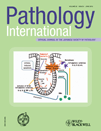
PATHOLOGY INTERNATIONAL
Scope & Guideline
Transforming Understanding Through Pioneering Research
Introduction
Aims and Scopes
- Molecular Pathology:
Research exploring genetic, epigenetic, and molecular alterations in various cancers, contributing to understanding tumor biology and potential therapeutic targets. - Clinical Pathology:
Studies that bridge laboratory findings with clinical outcomes, focusing on the diagnostic and prognostic implications of histopathological features in diseases. - Autopsy and Case Reports:
In-depth analyses of autopsy cases that provide insights into disease mechanisms and outcomes, contributing to the understanding of rare and complex conditions. - Innovative Diagnostic Techniques:
Development and assessment of novel diagnostic methods including advanced imaging, immunohistochemistry, and molecular profiling to enhance pathology practice. - Tumor Microenvironment:
Investigations into the role of the tumor microenvironment, including immune cell interactions and stromal components, in cancer progression and response to treatment. - Histopathological Classification:
Efforts to refine tumor classification systems that integrate histological and molecular characteristics to improve patient stratification and treatment options.
Trending and Emerging
- Integration of Genomic Data in Pathology:
An increasing emphasis on integrating genomic profiling with histopathological evaluation to inform personalized medicine and targeted therapies. - Artificial Intelligence in Diagnostics:
Growing interest in the application of artificial intelligence and machine learning techniques to enhance diagnostic accuracy and efficiency in pathology. - Immune Microenvironment Studies:
A rising focus on the immune landscape within tumors, including the characterization of immune cell types and their roles in tumor progression and response to therapy. - Pathological Mechanisms of COVID-19:
Emerging research on the pathological implications of COVID-19, particularly regarding its impact on various organ systems and post-viral complications, reflecting the pandemic's influence on pathology research. - Epigenetics in Cancer Pathology:
Increased attention to the role of epigenetic modifications in cancer development and progression, highlighting the complex interplay between genetics and environmental factors.
Declining or Waning
- Traditional Morphology Without Molecular Correlation:
There is a noticeable decline in studies focusing solely on traditional morphological assessments without integrating molecular or genomic data, as the field moves towards more comprehensive diagnostic approaches. - Single Case Studies with Limited Generalizability:
The publication of isolated case reports that lack broader implications or insights into larger trends in pathology is diminishing, as the journal favors studies with more significant clinical relevance. - Focus on Rare Tumors Without Broader Context:
While rare tumors remain important, there is a waning interest in studies that do not connect these findings to broader oncological principles or current diagnostic frameworks.
Similar Journals

Malaysian Journal of Pathology
Transforming understanding of disease through original research.Malaysian Journal of Pathology, published by the MALAYSIAN JOURNAL PATHOLOGY, stands as a pivotal resource in the fields of pathology and medicine, contributing rich insights since its inception in 1979. This peer-reviewed journal, based in Malaysia, is dedicated to disseminating original research, review articles, and case studies that advance the understanding of disease mechanisms and diagnostics. With a current impact factor reflecting its ranked positioning—Q4 in Cell Biology, Q4 in Histology, and Q3 in both Miscellaneous Medicine and Pathology & Forensic Medicine—this journal serves as an essential platform for researchers, clinicians, and students alike. Although it operates without open access, its scholarly rigor and contributions are well recognized, holding ranks such as #84 in Pathology and Forensic Medicine according to Scopus. The Malaysian Journal of Pathology is committed to fostering innovation and excellence in medical research, making it an invaluable tool for professionals seeking to stay abreast of significant advancements in the pathology domain.
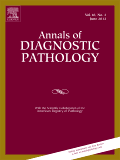
Annals of Diagnostic Pathology
Unveiling New Horizons in Pathologic Research.Annals of Diagnostic Pathology, published by Elsevier Science Inc, is a pivotal journal in the field of diagnostic pathology that has significantly contributed to the advancement of medical science since its inception in 1997. With an ISSN of 1092-9134 and E-ISSN of 1532-8198, this esteemed journal is positioned within the Q2 category in both Medicine (miscellaneous) and Pathology and Forensic Medicine, reflecting its high-quality research contributions, showcased by its ranking at #73 out of 208 in Scopus for the latter category. The journal's scope encompasses various aspects of diagnostic pathology, from innovative techniques to critical reviews of pathologic findings, making it an essential resource for researchers, medical professionals, and students dedicated to enhancing diagnostic accuracy and patient care. Although it does not currently offer open access options, its wide readership and impactful publications continue to influence clinical practices and research agendas. With a convergence period extending to 2024, Annals of Diagnostic Pathology remains a leading platform for disseminating valuable knowledge in this dynamic field.
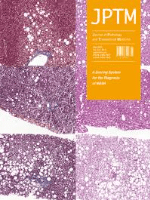
Journal of Pathology and Translational Medicine
Fostering Collaboration in Pathology and HistologyThe Journal of Pathology and Translational Medicine, published by the Korean Society of Pathologists, is a distinguished peer-reviewed Open Access journal that has been at the forefront of advancing the field of pathology and histology since its inception in 1985. With an established ISSN of 2383-7837 and an E-ISSN of 2383-7845, the journal serves as a vital platform for disseminating high-quality research, fostering collaboration among professionals and offering valuable insights into both clinical applications and theoretical advancements. Recognized for its influence in the field, it holds a commendable Q2 ranking in both Histology and Pathology & Forensic Medicine categories in 2023, and ranks #52/208 in Scopus for Medicine – Pathology and Forensic Medicine, demonstrating its impact and reach within the academic community. Located in South Korea at 1209 Gwanghwamun Officia, 92 Saemunan-ro, Jongno-gu, Seoul 03186, this journal not only caters to researchers and professionals but also supports students striving to deepen their understanding of pathology. Join the growing body of knowledge and stay updated with the latest findings in this essential field of study through the journal's open access format, promoting worldwide accessibility and engagement.

PATHOLOGICA
Driving Excellence in Pathology Research and Clinical Practice.PATHOLOGICA is a leading academic journal dedicated to the field of pathology and forensic medicine, published by PACINI EDITORE. With a rich history dating back to its inception in 1945, the journal has consistently contributed to the advancement of knowledge in these vital areas of medical research and practice. Currently ranked in the Q1 quartile for Pathology and Forensic Medicine and holding an impressive position as #42 out of 208 in the Scopus rankings, it reflects a significant impact within the academic community, boasting an 80th percentile ranking. The journal is committed to publishing high-quality, peer-reviewed articles that explore innovative research findings and clinical advancements, making it an essential resource for researchers, clinicians, and students alike. Though it does not offer open access, PATHOLOGICA continues to foster scholarly communication by disseminating cutting-edge research findings, thus playing a pivotal role in enhancing pathology education and practice worldwide.
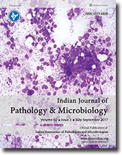
Indian Journal of Pathology and Microbiology
Navigating the Evolving Landscape of PathologyIndian Journal of Pathology and Microbiology, published by Wolters Kluwer Medknow Publications, is a distinguished open-access journal that has been fostering knowledge dissemination in the fields of pathology and microbiology since 2008. With an ISSN of 0377-4929 and E-ISSN 0974-5130, this journal serves as a critical resource for researchers and practitioners committed to advancing their understanding of medical sciences in India and beyond. Spanning decades of valuable research contributions since its establishment in 1972, it provides a platform for peer-reviewed articles that explore current trends and innovations in medicinal pathology and microbiological studies. Although it holds a Q4 ranking in categories such as medicine and microbiology, it maintains a notable Q3 classification in pathology and forensic medicine, highlighting its relevance to contemporary scientific discussions. Accessible freely to a global audience, the journal plays a pivotal role in enhancing scholarly communication and collaboration, making it an indispensable tool for students, professionals, and researchers alike aiming to contribute to this evolving discipline.

Journal of Pathology Clinical Research
Advancing the Frontiers of Pathology and Forensic MedicineThe Journal of Pathology Clinical Research is a prestigious academic platform published by WILEY, dedicated to advancing the field of pathology and forensic medicine. Since its inception in 2015, this Open Access journal has championed the dissemination of cutting-edge research relevant to both clinical practice and laboratory science, allowing for greater visibility and accessibility to researchers, professionals, and students worldwide. With a robust Q1 ranking in the Pathology and Forensic Medicine category for 2023, it stands as a critical resource for those seeking to stay at the forefront of the field, currently positioned at rank #29 out of 208 according to Scopus metrics, placing it in the 86th percentile. The journal's commitment to high-quality peer-reviewed articles fosters an environment of scholarly exchange that is essential for innovation and professional growth in pathology and forensic studies. Researchers and practitioners alike are encouraged to contribute and engage with a community dedicated to excellence in clinical research.
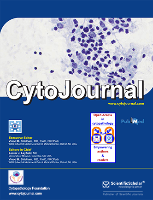
CytoJournal
Unlocking Insights in Pathology and Forensic Research.CytoJournal is a leading open-access journal focused on the fields of pathology and forensic medicine, published by SCIENTIFIC SCHOLAR LLC. With its esteemed reputation, the journal has achieved a Q2 ranking in the 2023 Category Quartiles in its field, indicating its significant contribution and impact among its peers. Over its convergence from 2004 to 2024, CytoJournal has established itself as a pivotal platform for researchers, professionals, and students to disseminate and exchange pioneering research findings related to cytopathology and diagnostic techniques. With an emerging Scopus rank of #115 out of 208 in the field, the journal maintains a solid percentile ranking of 44th, underlining its importance in the scientific community. CytoJournal's commitment to facilitating open access ensures that critical insights and advancements in pathology and forensic medicine are easily accessible to those at the forefront of this essential area of study.

HISTOLOGY AND HISTOPATHOLOGY
Unlocking the Mysteries of Disease MechanismsHISTOLOGY AND HISTOPATHOLOGY, published by F HERNANDEZ, is an esteemed academic journal dedicated to advancing the fields of histology and pathology. With its ISSN 0213-3911 and E-ISSN 1699-5848, this journal has been a crucial resource for researchers and professionals since its inception in 1986. The journal enjoys a strong reputation, evidenced by its Q2 category rankings in both Histology and Pathology & Forensic Medicine as of 2023, positioning it within the top tier of scholarly publications. With Scopus rankings placing it at Rank #74/208 in Medicine - Pathology and Forensic Medicine and Rank #31/62 in Medicine - Histology, it proves to be an essential platform for disseminating significant research findings and innovations. Although the journal is not open access, it is committed to providing high-quality, peer-reviewed articles that cater to the needs of its academic community. With a focus on fostering a deeper understanding of tissue structure and disease mechanisms, HISTOLOGY AND HISTOPATHOLOGY serves as an indispensable resource for students, researchers, and practitioners alike, facilitating the exchange of knowledge and pioneering research in these vital areas of study.

Turkish Journal of Pathology
Elevating Standards in Pathology Research and PracticeTurkish Journal of Pathology, published by the Federation Turkish Pathology Society, stands as a vital platform for disseminating high-quality research in the field of pathology and forensic medicine. With an ISSN of 1018-5615 and an E-ISSN of 1309-5730, this journal has been an open-access publication since 2013, ensuring that cutting-edge findings are readily available to the global community. Based in Turkey, it aims to contribute significantly to the advancement of pathology as it converges from 2010 to 2024, currently holding a Q3 quartile ranking in its category according to 2023 metrics. As it ranks #129 out of 208 in the Scopus database for Medicine, Pathology, and Forensic Medicine, it offers researchers, professionals, and students invaluable insights and innovative studies that address critical developments in the field. The Turkish Journal of Pathology fosters collaboration and knowledge-sharing, making it an essential resource for anyone involved in pathology research and practice.
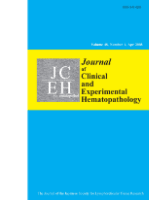
Journal of Clinical and Experimental Hematopathology
Unlocking Innovations in Hematology Research.The Journal of Clinical and Experimental Hematopathology, published by the Japanese Society of Lymphoreticular Tissue Research, is a vital resource dedicated to advancing the field of hematopathology. With an impressive Open Access model since 2019, this journal provides researchers, clinicians, and students from around the world with unfettered access to cutting-edge research and developments in hematology and pathophysiology. Based in Japan, it has established a prominent reputation in the academic community, boasting a Q3 quartile ranking in Hematology and Q1 rankings in both Medicine (Miscellaneous) and Pathophysiology as of 2023. With its innovative contributions and high visibility, the journal not only fosters scholarly discourse but also impacts clinical practices, making it an essential publication for anyone interested in the complexities of hematologic disorders. For submissions and further inquiries, the journal is located at Nagoya University Graduate School of Medicine, Japan.